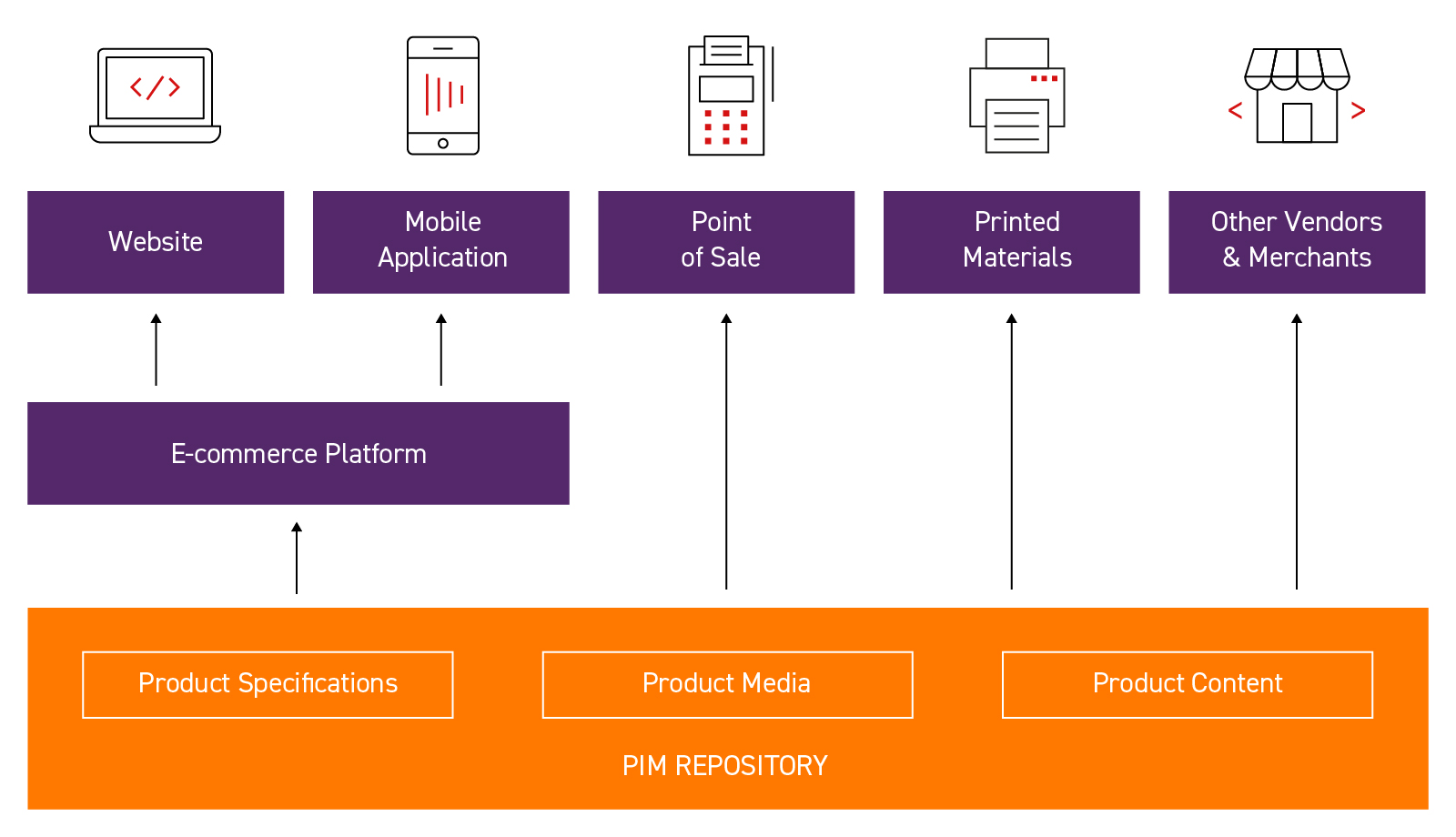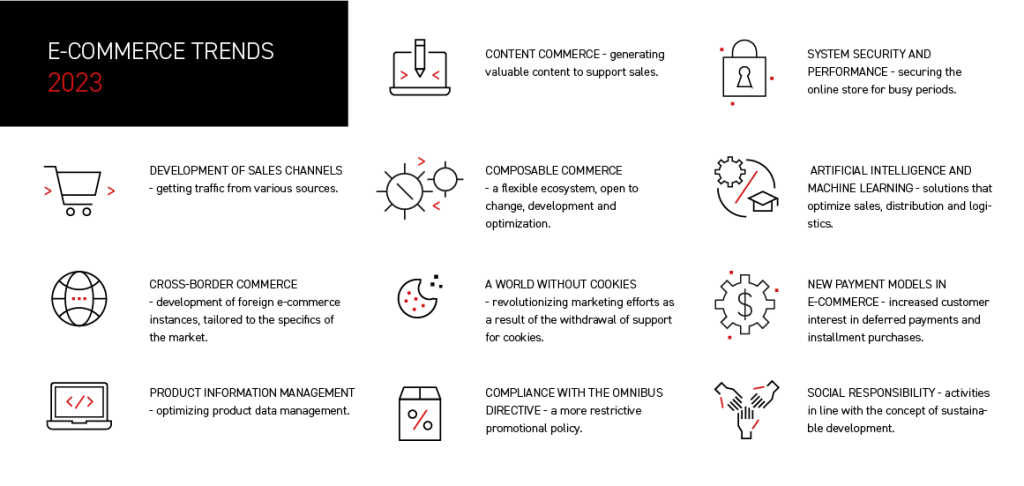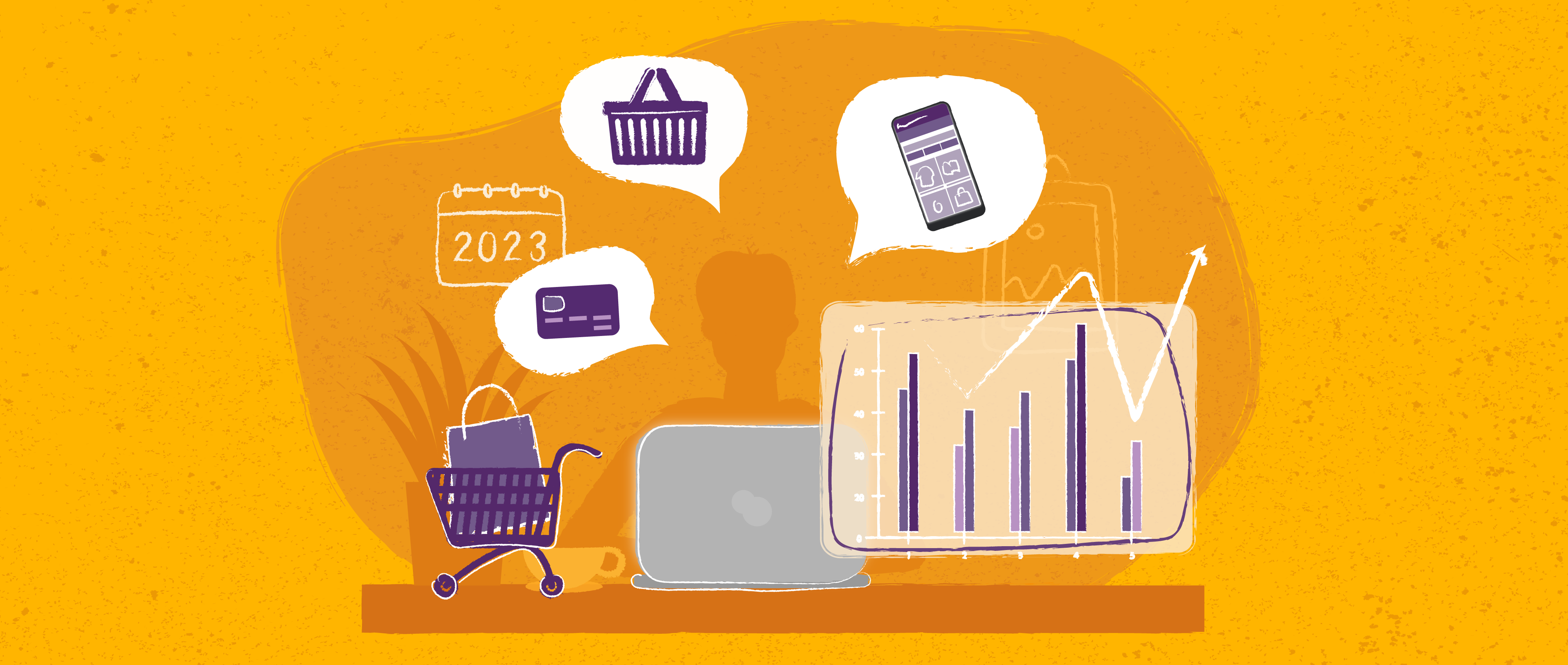E-Commerce Development in 2023 / Trends and Expert Tips
Due to the anticipated crisis, 2023 will be a tough year, which will undoubtedly affect the operations of many companies. After the difficult two-year pandemic, which disorganized or even crushed many businesses around the world, we will probably face such challenges as rampant inflation, energy problems and disrupted supply chains. The economic and political situation will affect the level of revenues, profitability and margins, and the growing costs will also reduce consumer spending and investments, with an impact on retailers, wholesalers and distributors.
It seems that online stores, offering easy access for every consumer, have the greatest odds of emerging from this testing period unscathed. In this article, we present our suggestions for e-commerce development that can help you grow sales and improve the trading performance of your business!
Development of Sales Channels
As we’ve mentioned above, one of the advantages of e-commerce over other sales channels is the ease of access for the consumer. Proprietors of online stores should therefore focus on attracting traffic from various sources and expanding their sales channels. By that we mean ensuring the availability of the offer, e.g. on marketplace platforms or in partner stores offering complementary products.
Cross-Border Commerce
It’s also worth looking for customers in new markets, namely by considering sales growth in the cross-border model. Distribution through an international or local marketplace might be the first step. The next step could be to develop foreign instances of your own store adapted to the specific market, taking into account local solutions in the area of payments, delivery or logistics.
It’s therefore worth making sure that your e-commerce platform facilitates roll-out to other markets, providing a functionality at the level of translation of the store’s website and integration with the above areas necessary to sell in other countries – e.g. a popular logistics operator or payment gateway.
Product Information Management
Sales development in the cross-border model is linked to the topic of product information management – notably the ability to easily customize product content. Translating the content is greatly facilitated by the use of a PIM (Product Information Management) system.
PIM is of help in many activities related to the preparation of product data – e.g. when building category trees, which can present products divided by markets, or display various product details, e.g. a description, photos or attributes.

Content Commerce
Content Commerce is a very interesting trend that should be mentioned here. It’s about generating a significant volume of valuable text and visual content to drive e-commerce sales.
This is more than just a skilful running of a blog, as it involves the perfect combination of exciting content with good quality product data. The whole thing is presented to a precisely selected audience that are ready to buy products encouraged by the information they receive. It should be noted that this has nothing to do with manipulation – this is about providing consumers with knowledge: essential, detailed information embedded in context. Excellent results and efficiency are achieved here by using and integrating three classes of solutions: PIM, CMS/DXP and CDP (Customer Data Platform).
Composable Commerce and Open MACH Approach
It’s been known for long that “Content is King” and that content – specifically “rich content” – can sell. After all – or above all – we buy what we see.
How, where and to what audience we will effectively “serve” and convert the content also depends on the class of the CMS (Content Management System). Understandably, the CMS itself should be part of a larger, well-adjusted “sales ecosystem”, one that is open to changes, development and optimization to be able to fully leverage the potential of being future-proof. Just like in composable commerce solutions. In this “composition”, we recommend using headless CMSs, which are part of the MACH* architecture approach. As CMSs have a presentation layer that is separate from the backend, this allows us to easily and quickly deliver omnichannel content and positively influence the user experience.
As opposed to “monolithic” and hard-to-develop systems, the MACH approach and its composable solutions enable targeted, fast, agile and scalable activities aimed at building a competitive edge, even when the times are difficult for business.
*MACH is an acronym of Microservices, API first, Cloud native, and Headless, and at the same time a direction for more effective adaptation to the ongoing changes without the need to remodel the entire IT infrastructure or make “either-or” business choices. MACH is not an “all-or-nothing” approach – it can be implemented gradually as the uncertain future unfolds.

A New Approach to Paid Traffic – A World Without Cookies
In the case of campaigns supporting the generation of paid traffic, let’s pay attention to the consequence of withdrawing support for third party cookies in all browsers. In practice, this will mean a revolution for popular and effective advertising activities – from Adwords to contextual advertising offered by publishers and media houses. The effectiveness of behavioral targeting will be limited when advertisers use data that are less precise than today. At the same time, the gap left after the elimination of 3rd party cookies will be filled by other methods, e.g. Facebook Conversions API, extended conversions in Google Ads, or Privacy Sandbox. The challenge for both advertisers and marketers will be to figure out which solutions will work best in the new reality.
Compliance With the Omnibus Directive
Next year, online stores will have to pay more attention to how they operate their special offer policies in the light of the Omnibus Directive, which entered into force at the end of May 2022. One of the many requirements of the Directive is to inform customers about the lowest price applied to the goods over the 30 days prior to the start of a price reduction or promotion. This is designed to protect buyers against unfair practices.
It’s assumed that while the latter half of 2022 will still be characterized by a somewhat lenient approach from inspection authorities, in 2023 compliance with those regulations will be rigorously checked. E-stores must include appropriate features informing customers about the prior price in different areas of the platform. This is important, as due to the need to attract new business in difficult times sellers will resort to various promotional scenarios, and price and product configurations (product sets, product bundles, etc.).

System Security and Performance
The fourth quarter of the year is the harvest time for a large number of companies from the retail sector. In some industries, the revenue generated during this time accounts for most of their annual turnover. Consumers participate in Black Friday and Cyber Monday sales (often promotions continue throughout the Black Week). And soon the Christmas shopping frenzy will begin. It’s often heralded that 2023 will be a much tougher time for business, so everyone should take care of the security and efficiency of their e-commerce platform. To this end, it’s a good idea to make sure that the performance of the website is secured in the event of significantly increased traffic, and ready to handle sales peaks. You should also ensure the proper monitoring of the e-commerce application and check the steps of the shopping path to make sure it’s free of errors that might prevent an online purchase.
Artificial Intelligence and Machine Learning
In the era of increased competition for e-store traffic, higher conversion, better customer service and quick delivery, machine learning is gaining in importance. In particular, large companies from the retail and distribution sector should consider introducing those solutions in their supply chains for better forecasting and optimization of their activities. This will lead to shorter delivery and turnaround times, while boosting the company’s efficiency, which will certainly be noted by customers.
Increasingly often, service optimization is helped by voice bots, which collect information about orders with an immediate updating of stock levels in the WMS or the ERP system. The same goes for the use of data science in sales. This allows demand to be forecast and similarities to be determined between the goods purchased by customers. In consequence, data science enables stores to apply such promotional activities that in practice will lead to an increased business efficiency.
New Payment Models in E-commerce
When gearing up for operations during the crisis, it’s worth taking into account the changing shopping habits of consumers and offering them instalment plans and the increasingly popular deferred payment plans. With those solutions in place, consumers will be able to buy goods by paying for them many days after the purchase.
For an even greater convenience, buyers may also use payments correlated with an extended time for returning the goods. The latter option allows consumers to pay only after expiry of the time limit for returning the goods (for example, after 30 days).
Social Responsibility
Last but not least, we should mention social trends that have an impact on purchasing decisions – particularly those taken by representatives of generations Y and Z. This is primarily a strong sense of social responsibility, expressed by care for the natural environment, as well as human rights and equality of gender, race, religion, beliefs, etc.
In the era of fighting for the client, it’s worth considering actions that fit into the concept of sustainable development – as well as supporting the objectively noble idea of sustainability, this will surely attract the attention of potential clients.
Summary
It’s difficult to clearly predict what 2023 has in store and what challenges business representatives will have to face. Fortunately, most companies weathered the turbulent times of the global pandemic, acquiring the ability to adapt to rapidly changing conditions. They will certainly benefit from this strength in the future as well.
Despite the period of uncertainty and evolving consumer behaviors, the e-commerce market is constantly growing. Companies that will act fast and implement an appropriate e-commerce strategy, in line with the latest shopping trends, will have a much better chance to meet the upcoming challenges and be more successful that their competition. Good luck!
Want to learn more about the latest e-commerce trends? Let’s talk!







